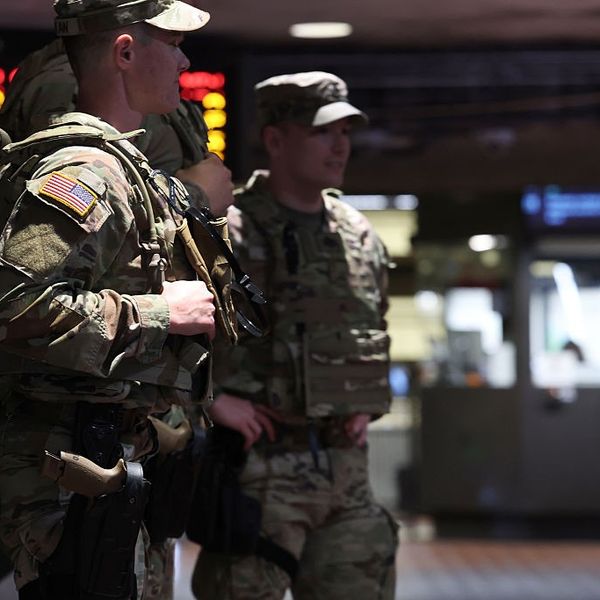
This mural is part of the 12 Hours Campaign in Sana'a, Yemen. Artists include Hadeel Almoafak, Hanan Alsurmi, Thi yazen Alalawi, and Murad Subay (Photograph courtesy of Murad Subay)
In 'Targeted' US Drone Strikes, Vast Majority Killed Are Those Not Targeted: Study
According to report from Reprieve, up to 1,147 unnamed people have been killed in pursuit of 41 men on the US Kill List
The U.S. government's so-called "pinpoint" drone strikes in Pakistan and Yemen are, in fact, leaving wide perimeters of death, as people on the Kill List are targeted--and even reported dead--again and again, according to a report published Monday by the UK-based charity Reprieve.
While drone attacks and their victims are kept secret by the U.S. military and government, Reprieve compiled public information available, most of it from media reports and the Bureau of Investigative Journalism, to determine who actually died when the U.S. went after individuals in Yemen and Pakistan between November 2002 and November 2014.
The study examines the cases of 41 people included on a Kill List--a classified U.S. assassination program personally approved by President Obama with no judicial or public oversight. According to the report's findings, up to 1,147 unnamed people were killed in pursuit of these 41 known individuals.
Furthermore, each of these 41 men was reported killed multiple times.
"This raises a stark question," states the study. "With each failed attempt to assassinate a man on the Kill List, who filled the body bag in his place? In fact, it is more accurate to say 'body bags': many other lives are sacrificed in the effort to erase a name from the Kill List."
Drone bombings of 24 men in Pakistan included on the Kill List led to the deaths of 874 people, 142 of them children. Each of these 24 men were reported killed by the press multiple times, and only six of them are known to have died in strikes.
One victim was 8-year-old Noor Syed, who was killed along with 30 other people by a February 2009 U.S. drone bombing in Makeen, South Waziristan in Pakistan. The attack that took the child's life was supposedly targeting Baitullah Mehsud, allegedly of the Pakistani Taliban. According to press reports compiled by Reprieve, the February bombing was at least the second attempt to assassinate Mehsud, who was eventually killed after at least five attempts on his life.
"How can the U.S. invade our homes while we are sleeping and target our children?" Noor's grandfather asked a reporter following the child's funeral.
In Yemen, 17 men were targeted and reported dead multiple times each, resulting in a total of 273 people killed, at least seven of them children.
The data contradicts repeated claims by the U.S. government, including a statement by President Obama in 2012, in which he declared, "I want to make sure that people understand: actually, drones have not caused a huge number of civilian casualties. For the most part they have been very precise precision strikes against Al Qaeda and their affiliates."
However, the report exposes just a fraction of the lives lost to the U.S. drone program, as it does not include people who are targeted only once, nor drone strikes that do not target specific, known people. Furthermore, Katherine Oshea, spokesperson for Reprieve, told Common Dreams that U.S. secrecy presented an obstacle to investigators.
"We need more transparency on the drone program," said Oshea. "Innocent victims of it are hearing one thing from the administration and seeing another thing with their own eyes."
According to estimates from the Bureau of Investigative Journalism, up to 4,404 people have been killed in as many as 486 drone strikes (some possibly not by the U.S.) in Pakistan and Yemen between 2004 and 2014. The conservative Council on Foreign Relations reports that 500 "non-battlefield targeted killings," meaning U.S. drone strikes outside of Iraq and Afghanistan, have killed an estimated 3,674 people, 473 of them civilians.
An Urgent Message From Our Co-Founder
Dear Common Dreams reader, The U.S. is on a fast track to authoritarianism like nothing I've ever seen. Meanwhile, corporate news outlets are utterly capitulating to Trump, twisting their coverage to avoid drawing his ire while lining up to stuff cash in his pockets. That's why I believe that Common Dreams is doing the best and most consequential reporting that we've ever done. Our small but mighty team is a progressive reporting powerhouse, covering the news every day that the corporate media never will. Our mission has always been simple: To inform. To inspire. And to ignite change for the common good. Now here's the key piece that I want all our readers to understand: None of this would be possible without your financial support. That's not just some fundraising cliche. It's the absolute and literal truth. We don't accept corporate advertising and never will. We don't have a paywall because we don't think people should be blocked from critical news based on their ability to pay. Everything we do is funded by the donations of readers like you. The final deadline for our crucial Summer Campaign fundraising drive is just days away, and we’re falling short of our must-hit goal. Will you donate now to help power the nonprofit, independent reporting of Common Dreams? Thank you for being a vital member of our community. Together, we can keep independent journalism alive when it’s needed most. - Craig Brown, Co-founder |
The U.S. government's so-called "pinpoint" drone strikes in Pakistan and Yemen are, in fact, leaving wide perimeters of death, as people on the Kill List are targeted--and even reported dead--again and again, according to a report published Monday by the UK-based charity Reprieve.
While drone attacks and their victims are kept secret by the U.S. military and government, Reprieve compiled public information available, most of it from media reports and the Bureau of Investigative Journalism, to determine who actually died when the U.S. went after individuals in Yemen and Pakistan between November 2002 and November 2014.
The study examines the cases of 41 people included on a Kill List--a classified U.S. assassination program personally approved by President Obama with no judicial or public oversight. According to the report's findings, up to 1,147 unnamed people were killed in pursuit of these 41 known individuals.
Furthermore, each of these 41 men was reported killed multiple times.
"This raises a stark question," states the study. "With each failed attempt to assassinate a man on the Kill List, who filled the body bag in his place? In fact, it is more accurate to say 'body bags': many other lives are sacrificed in the effort to erase a name from the Kill List."
Drone bombings of 24 men in Pakistan included on the Kill List led to the deaths of 874 people, 142 of them children. Each of these 24 men were reported killed by the press multiple times, and only six of them are known to have died in strikes.
One victim was 8-year-old Noor Syed, who was killed along with 30 other people by a February 2009 U.S. drone bombing in Makeen, South Waziristan in Pakistan. The attack that took the child's life was supposedly targeting Baitullah Mehsud, allegedly of the Pakistani Taliban. According to press reports compiled by Reprieve, the February bombing was at least the second attempt to assassinate Mehsud, who was eventually killed after at least five attempts on his life.
"How can the U.S. invade our homes while we are sleeping and target our children?" Noor's grandfather asked a reporter following the child's funeral.
In Yemen, 17 men were targeted and reported dead multiple times each, resulting in a total of 273 people killed, at least seven of them children.
The data contradicts repeated claims by the U.S. government, including a statement by President Obama in 2012, in which he declared, "I want to make sure that people understand: actually, drones have not caused a huge number of civilian casualties. For the most part they have been very precise precision strikes against Al Qaeda and their affiliates."
However, the report exposes just a fraction of the lives lost to the U.S. drone program, as it does not include people who are targeted only once, nor drone strikes that do not target specific, known people. Furthermore, Katherine Oshea, spokesperson for Reprieve, told Common Dreams that U.S. secrecy presented an obstacle to investigators.
"We need more transparency on the drone program," said Oshea. "Innocent victims of it are hearing one thing from the administration and seeing another thing with their own eyes."
According to estimates from the Bureau of Investigative Journalism, up to 4,404 people have been killed in as many as 486 drone strikes (some possibly not by the U.S.) in Pakistan and Yemen between 2004 and 2014. The conservative Council on Foreign Relations reports that 500 "non-battlefield targeted killings," meaning U.S. drone strikes outside of Iraq and Afghanistan, have killed an estimated 3,674 people, 473 of them civilians.
The U.S. government's so-called "pinpoint" drone strikes in Pakistan and Yemen are, in fact, leaving wide perimeters of death, as people on the Kill List are targeted--and even reported dead--again and again, according to a report published Monday by the UK-based charity Reprieve.
While drone attacks and their victims are kept secret by the U.S. military and government, Reprieve compiled public information available, most of it from media reports and the Bureau of Investigative Journalism, to determine who actually died when the U.S. went after individuals in Yemen and Pakistan between November 2002 and November 2014.
The study examines the cases of 41 people included on a Kill List--a classified U.S. assassination program personally approved by President Obama with no judicial or public oversight. According to the report's findings, up to 1,147 unnamed people were killed in pursuit of these 41 known individuals.
Furthermore, each of these 41 men was reported killed multiple times.
"This raises a stark question," states the study. "With each failed attempt to assassinate a man on the Kill List, who filled the body bag in his place? In fact, it is more accurate to say 'body bags': many other lives are sacrificed in the effort to erase a name from the Kill List."
Drone bombings of 24 men in Pakistan included on the Kill List led to the deaths of 874 people, 142 of them children. Each of these 24 men were reported killed by the press multiple times, and only six of them are known to have died in strikes.
One victim was 8-year-old Noor Syed, who was killed along with 30 other people by a February 2009 U.S. drone bombing in Makeen, South Waziristan in Pakistan. The attack that took the child's life was supposedly targeting Baitullah Mehsud, allegedly of the Pakistani Taliban. According to press reports compiled by Reprieve, the February bombing was at least the second attempt to assassinate Mehsud, who was eventually killed after at least five attempts on his life.
"How can the U.S. invade our homes while we are sleeping and target our children?" Noor's grandfather asked a reporter following the child's funeral.
In Yemen, 17 men were targeted and reported dead multiple times each, resulting in a total of 273 people killed, at least seven of them children.
The data contradicts repeated claims by the U.S. government, including a statement by President Obama in 2012, in which he declared, "I want to make sure that people understand: actually, drones have not caused a huge number of civilian casualties. For the most part they have been very precise precision strikes against Al Qaeda and their affiliates."
However, the report exposes just a fraction of the lives lost to the U.S. drone program, as it does not include people who are targeted only once, nor drone strikes that do not target specific, known people. Furthermore, Katherine Oshea, spokesperson for Reprieve, told Common Dreams that U.S. secrecy presented an obstacle to investigators.
"We need more transparency on the drone program," said Oshea. "Innocent victims of it are hearing one thing from the administration and seeing another thing with their own eyes."
According to estimates from the Bureau of Investigative Journalism, up to 4,404 people have been killed in as many as 486 drone strikes (some possibly not by the U.S.) in Pakistan and Yemen between 2004 and 2014. The conservative Council on Foreign Relations reports that 500 "non-battlefield targeted killings," meaning U.S. drone strikes outside of Iraq and Afghanistan, have killed an estimated 3,674 people, 473 of them civilians.

